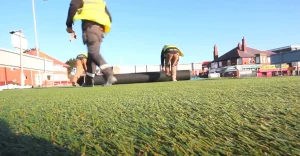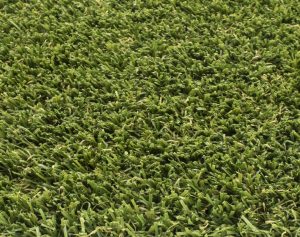Yes — you can lay artificial grass directly onto concrete, but only if you prepare it properly. Done right, it transforms old patios, paving, and even play areas into a soft, green surface that feels and looks like a real lawn. Done wrong, you’ll end up with puddles, peeling edges, or turf that doesn’t last.
At As Good As Grass, we’ve been fitting lawns for over 20 years, and we’ll walk you through the exact process below — so you can tackle it yourself, or call in our team if you’d rather leave it to the professionals.
Why Lay Artificial Grass on Concrete?
Concrete is practical but rarely pretty. Over time it becomes dull, cracked, and slippery in wet weather. Artificial grass instantly brightens up tired patios and yards, making them safer and far more inviting.
- Instant facelift – cover up unattractive concrete with a lush green finish.
- Non-slip and safer – no moss, no ice-rink effect in winter.
- Quick install – no heavy groundworks needed compared to soil.
- Child and pet friendly – add a foam underlay for extra comfort.
- Long-lasting – a well-installed lawn can last 10+ years with minimal upkeep.
Thinking of a full home makeover? Explore our residential artificial grass options.
Is Your Concrete Suitable?
Before you start, check the condition of the surface.
- Stable and mostly flat? Great — you can install straight on top.
- Minor cracks or dips? Fill them with self-levelling compound.
- Loose slabs or large cracks? These need fixing, or the grass won’t bond properly.
- Drainage issues? If puddles form, drill 16 mm holes where water gathers and fill with shingle.
For safety play areas, check out our artificial grass for schools and nurseries.
Tools & Materials You’ll Need
Before you get stuck in, gather the essentials. Having the right kit makes all the difference.
- Stiff broom and hose / jet wash
- Artificial grass rolls (allow extra for cuts)
- Foam underlay (5–10 mm for comfort & safety)
- Outdoor adhesive & seaming tape
- Sharp knife with spare blades
- Kiln-dried sand (optional but recommended)
- Protective gloves & knee pads
Not got everything to hand? Our installation teams fit over 500 lawns a year — and we’re happy to handle the heavy lifting for you. Ask us for a free survey.
Step-by-Step: How to Lay Artificial Grass on Concrete
Laying turf on concrete is quicker than on soil, but the details matter. Here’s the method we recommend:
Step 1. Clean the Concrete
Sweep or jet wash to remove moss, dirt, and grease. Let it dry fully — adhesive won’t stick to damp surfaces.
Step 2. Sort the Drainage
Test with a hose. If puddles form, drill 16 mm holes at low points and fill with gravel or shingle.
Step 3. Lay Foam Underlay
Roll out foam across the surface for comfort and safety. Tape joins together. This cushions the ground, hides small imperfections, and makes the lawn feel natural underfoot.
Step 4. Cut Grass to Fit
Unroll the turf and cut from the back with a sharp knife. Leave a small overhang at edges until everything is secured.
Step 5. Join Grass Sections
If you’re using more than one roll, align the pile direction and use seaming tape with adhesive for invisible joins.
Step 6. Secure the Perimeter
Fold edges back and apply adhesive in a continuous line. Leave small gaps in glue beads to allow water to drain away.
Step 7. Add Sand Infill & Brush
Spread 4–5 kg of kiln-dried sand per m² and brush it in against the pile. This keeps fibres upright, improves weight distribution, and helps the grass last longer.
Prefer a guaranteed finish? Book our artificial grass installation service.
Extra Tips for Concrete Installs
A concrete base can be a shortcut, but the little details make or break the finish. Here are a few pro tips that’ll help your grass feel softer, last longer, and stand up to pets, play, and all-weather use.
- Use free-drainage foam — not recycled foam that holds water and odours.
- For dogs, choose polyurethane-backed turf to resist urine smells.
- Let grass rest overnight before gluing to reduce wrinkles.
- Save offcuts for mats, putting greens, or pet play zones.
Our dog-friendly artificial grass is built to handle paws, play, and accidents.
FAQs About Laying Artificial Grass on Concrete
Wondering about drainage, adhesives, or whether it’s safe for dogs? You’re not the only one. Here are the most common questions we get asked about fitting artificial grass onto concrete — with straight answers based on years of installs.
Can you put artificial grass straight onto concrete?
Yes, but you’ll get the best result with foam underlay and proper drainage.
What’s the best adhesive for artificial grass on concrete?
Two-part polyurethane adhesive is strongest for outdoor use.
Do you need drainage under fake grass?
Yes — if puddles form, drill holes before installing.
Is it safe for dogs and kids?
Absolutely. Add a foam pad for extra comfort and choose pet-safe backing.
How long does artificial grass last on concrete?
With correct fitting, easily 10+ years.
For costs and options, read our artificial grass pricing guide.
DIY vs Professional Installation
DIY saves money, but it’s physical work and adhesive can be tricky to handle in large areas. Professional installation gives you perfect joins, smoother finishes, and better drainage — adding years to the lifespan of your lawn.
As we always say: we’re not the cheapest, because we don’t cut corners. But we are the best value if you want it done properly.
Our team covers Bury, Bolton, Rochdale, Oldham, and the wider Greater Manchester area. Get your free survey today.
Want to cover up tired concrete? We supply and install premium artificial grass across Greater Manchester and Lancashire — with a 10-year product guarantee. Request a Free Survey & Quote or see our Manchester service area.



